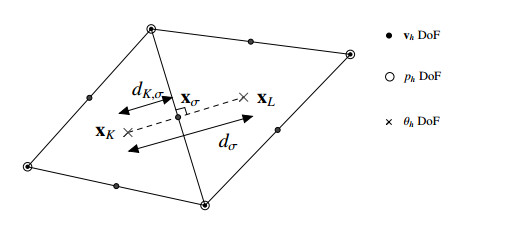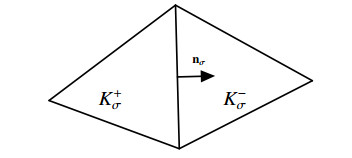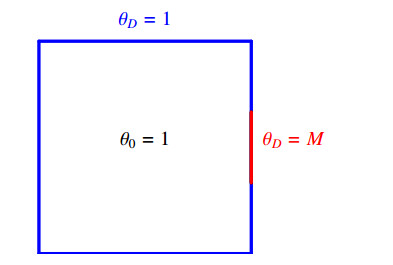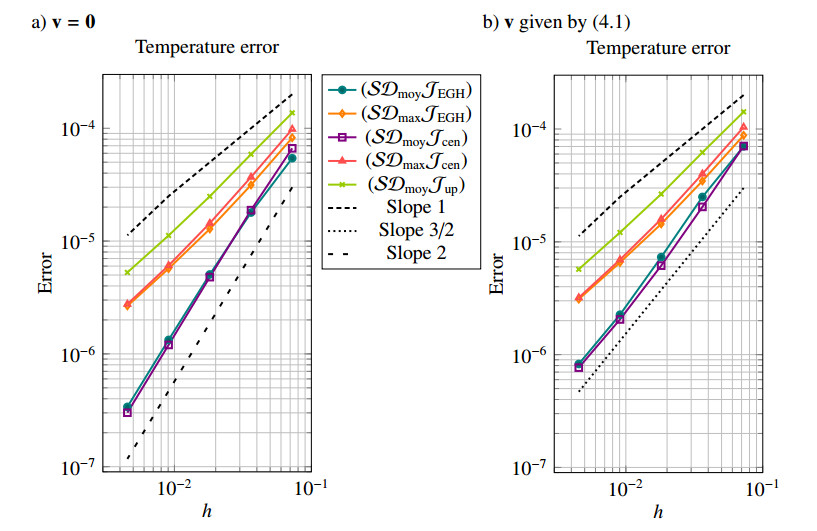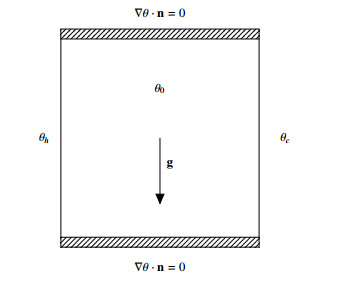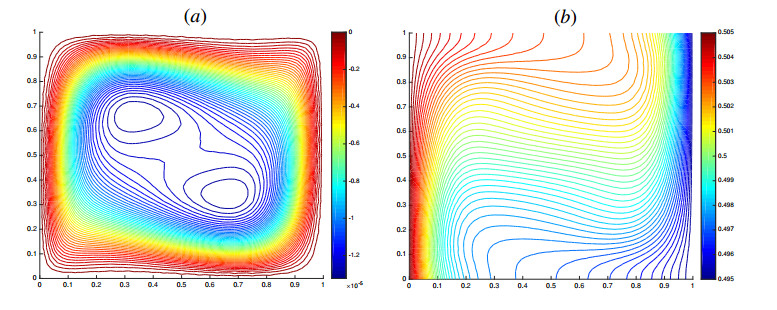In this paper, we propose a combined finite volume - finite element scheme, for the resolution of a specific low-Mach model expressed in the velocity, pressure and temperature variables. The dynamic viscosity of the fluid is given by an explicit function of the temperature, leading to the presence of a so-called Joule term in the mass conservation equation. First, we prove a discrete maximum principle for the temperature. Second, the numerical fluxes defined for the finite volume computation of the temperature are efficiently derived from the discrete finite element velocity field obtained by the resolution of the momentum equation. Several numerical tests are presented to illustrate our theoretical results and to underline the efficiency of the scheme in term of convergence rates.
1.
Introduction
Epidemic dynamics is a crucial method for the quantitative study of infectious diseases, developing mathematical models that represent the process of disease progression and the principles of transmission. Mathematical research has achieved significant advances in both theory and application, leading to several well-known models of infectious disease dynamics [1,2,3,4].
Numerous researchers have explored mathematical models concerning population-level transmission dynamics, such as SIR model that susceptible-infected-recovered-infectious disease model and SIRS model is based on the SIR model with the addition of the process of loss of immunity, among others[1]. These models have been studied and analyzed from various perspectives, including incidence, treatment functions, and age structure. Many reliable conclusions have emerged, contributing to the advancement of infectious disease dynamics [3,4,5,6]. For example, Li et al. [5] investigated epidemic models of the SIR and SIRS types with a general contact rate and constant immigration, particularly emphasizing the impact of the influx of infectious individuals. The model complexity and greater stochastic volatility of multiparameter stochastic perturbations have resulted in relatively little relevant research. The purpose of this study is to investigate the extinction and persistence of stochastic SIRSW model solutions under multiparameter stochastic perturbations, the propagation laws of infectious disease dynamics, and the effects of different parameters on disease spread. Among these, the SIRSW model is based on the SIRS model, adding the environmental pathogen infection process.
In recent years, due to environmental degradation and varying degrees of contamination of water and food, people have faced numerous infectious diseases stemming from environmental issues[7]. Infectious diseases such as cholera, tuberculosis, and COVID-19 exhibit spatial-temporal and multi-scale characteristics, including direct transmission between humans at the macroscale population level and indirect transmission between humans and environmental pathogens at the microscale [8,9,10,11]. In the environmental transmission of certain infectious diseases, the excretion of pathogens and their transmission are two major processes. Additionally, between-host disease transmission and within-host viral load are interdependent[12]. To investigate the effects of individual movement and pathogen dispersal in space on disease transmission, Xiao et al.[13] developed a coupled model that considers direct infection resulting from random human movements and indirect infection following pathogen shedding in the environment, which took the following form
where N denotes the total population, S,I,R are the number of susceptible, infected, and recovered individuals, W(t) is the pathogen concentration in the environment at time t, respectively, β is the direct transmission rate, ν is the indirect transmission rate, η is the environmental virus shedding rate, μ is the natural mortality rate, and γ is the rate of recovery of infected individuals. Xiao et al. performed a numerical simulation analysis from a data-driven perspective and reached many interesting conclusions, but no theoretical analysis was performed. In the following section, refining the theoretical analyses of the corresponding models is also an important research objective of this paper.
Deterministic modeling of viral infections has been studied by some researchers[14,15,16]. Edoardo[14] proposes a mathematical model of the marine bacteriophage infection and analyzes its basic mathematical features. Ivo et al.[15] extended the Beretta-Kuang model to allow the estimation of virus growth parameters under model-specific parameterizations. Depending on the characteristics of the infection, the recovering person loses immunity after a period of time and becomes susceptible to infection again, which is called SIRS infection[17]. On this basis, by considering birth and death rates, the following deterministic model is obtained:
where Λ is the input rate of susceptible individuals, ζ denotes the rate of immune loss, and c denotes the rate of viral failure. The environmental pathogen concentration level is denoted by W. Denote
By calculation, model (1.2) has a disease-free equilibrium
and exists an endemic equilibrium
The basic reproduction number
is obtained by using the next generation matrix method. Further, if R0<1, E0 is globally asymptotically stable in D (in Remark 1). If R0>1, E∗ is globally asymptotically stable in D.
In the realm of infectious diseases transmission, the coefficients governing this process are frequently affected by stochastic environmental disturbances [18,19]. This environmental interference can be mathematically characterized as standard Brownian motion. Relying solely on deterministic models to describe and predict the evolution of disease dynamics and transmission mechanisms is often inadequate. Hence, there is an increasing recognition of the practical significance of investigating infectious disease models that incorporate stochastic factors, leading to a growing scholarly focus on these stochastic frameworks in recent years [20,21,22]. For instance, Ji et al.[23,24] explored the threshold behavior of the SIR infection model in the presence of stochastic noise perturbations, examining both the persistence and extinction dynamics of the SIR model under various stochastic perturbation patterns. They derived threshold conditions for disease extinction and persistence utilizing Itô's formula and the stochastic comparison theorem. In another study, Zhao et al. [25] investigated a class of stochastic SIRS models characterized by saturated incidence, taking into account the dynamics of recovered individuals who lose immunity and revert to susceptibility after a period. They established conditions for disease extinction and persistence through the stochastic comparison theorem, supported by numerical simulations that corroborated their theoretical findings. Yang et al. [26] developed a stochastic multi-scale COVID-19 model that integrates both within-host and between-host dynamics, employing interval parameters. This model was derived through fast-slow decoupling via singular perturbation theory, distinguishing between a rapid within-host model and a slower between-host stochastic model. Rihan et al.[27,28] developed a stochastic epidemiological SIRC model to study the transmission of COVID-19 with cross-immunity classes and time-delayed transmission terms. Which the SIRC model is a new partition added to the SIR model, cross immunity (C). Echoing the insights of Mao et al. [29], this paper posits that fluctuations in the environment predominantly manifest as variations in the transmission coefficient
where Bi(t) is a standard Brownian motion and σi>0 indicates the white noise intensity, i=1,2. Then we have
Our model considers the loss of immunity rate and the effects of random disturbances based on Xiao et al.[13], investigating a stochastic SIRSW model that accounts for environmentally driven infection and incorporates multiparameter perturbations. It innovatively examines the impacts of both direct and indirect transmission rates on the spread of the disease through multiparameter perturbations. This model is more comprehensive and aligns more closely with real-world situations. However, as a multi-scale model that integrates macro and micro perspectives, it is challenging to unify the data across temporal and spatial scales. The numerical simulation remains relatively idealized, and there is still a significant gap between the results and the actual inter-evolutionary outcomes. It considers environmental pathogen infections with stochastic perturbations in two key parameters: direct and indirect transmission rates. We conclude that, compared to perturbations in the indirect infection rate, changes in noise intensity affecting the direct infection rate have a more significant impact on disease transmission. Additionally, we find that the direct transmission rate notably influences the threshold of Rs0. These parameters are crucial for analyzing the impact of environmental fluctuations on disease dynamics.
The structure of the paper is delineated as follows: In Sections 1 and 2, we present the foundational concepts, along with relevant notations and lemmas essential for our analysis. Section 3 is devoted to establishing the existence and uniqueness of global positive solutions for the SIRS infectious disease system under consideration. In Sections 4 and 5, we explore the sufficient conditions that govern the persistence and extinction of the stochastic SIRS infectious disease model. Section 6 focuses on analyzing the asymptotic stability of the disease-free equilibrium, as well as the endemic equilibrium of the deterministic counterpart to the stochastic model. To conclude, we provide a series of numerical simulations accompanied by a summary of our principal findings, aimed at elucidating the theoretical results presented throughout the paper.
2.
Preliminaries
In this paper, unless otherwise stated, let (Ω,F,{Ft}t≥0,P) denote the complete probability space of the filtration Ftt≥0 that satisfies the regularity condition. Let Bi(t)(i=1,2) denote the independent standard Brownian motions defined on this complete probability space. For any a,b∈R, note that
For convenience, the following symbols have been introduced,
Lemma 1. [30] (Strong law of large number) Let
be a real-valued continuous local martingale, and
Then,
and
Lemma 2. [23] Suppose f∈C[Ω×[0,+∞),R+] if there exists a positive ordinal λ,λ0, such that
Then, for any t≥0, there are F∈C[Ω×[0,+∞),(−∞,+∞)] and
a.s., such that
Lemma 3. Suppose f∈C[Ω×[0,+∞),R+] if there exists a positive ordinal λ,λ0, such that
Then, for any t≥0, there are F∈C[Ω×[0,+∞),(−∞,+∞)] and
a.s., such that
Remark 1. For the model (1.3), we have
and we assume the initial values (S0,I0,R0,W0)∈D, which shows that the positive invariant set of the model is
3.
Existence and uniqueness of the global positive solution
The following theorem will show the existence and uniqueness of global positive solutions of system (1.3).
Theorem 1. For any initial value (S(0),I(0),R(0),W(0))∈R4+, there exists a positive salutation (S(t),I(t),R(t),W(t)) of the stochastic model (1.3) for t≥0, and the solution will hold in R4+ with probability one.
Proof. Since the coefficients of the model (1.3) satisfy the local Lipschits condition, for any S(0),I(0),R(0),W(0))∈R4+, there exists a locally unique solution (S(t),I(t),R(t),W(t)) on t∈[0,τε), where τe denotes the moment of explosion. It is sufficient to show that
Let k0≥1 denote a sufficiently large constant, and we have that S(0),I(0),R(0),W(0) are all in the interval [1k0,k0]. For any constant k>k0, define the stopping time,
or
Let
usually, ∞ denotes the empty set. Clearly, {τk}k≥k0 is a monotonically increasing function. If
then τ∞≤τe a.s. If
then for any t≥0,τe=∞, and (S(t),I(t),R(t),W(t))∈R4+a.s. Assuming that τ∞≠∞, there exist a constant T≥0 and ε∈(0,1) such that
where, for any k≥k0, there exists a constant k1≥k0 such that, when all the k≥k1, there is
Define a C2-equation V: R4+→R+ as follows:
Apply the Itˆo's formula
where,
Because of the mean value theorem, we can obtain
where,
H is a positive constant which is independent of S(t),I(t),R(t),W(t),t. Integrate both sides of the Eq (3.2) from 0 to
and then take the expectation as follows:
By using Gronwall inequality [31], we have
Let
and by the inequality (3.1), it is known that
For any ω∈Ωk, S(τk,ω),I(τk,ω),R(τk,ω),W(τk,ω), at least one of them equals 1k or k, therefore,
Combined with the above Eqs (3.2) and (3.8), we can get
Here IΩk(ω) is the indicator function for Ωk. When k→+∞, there are
This is a clear contradiction, and it is proved that
a.s. Thus, the theorem can be proved. □
4.
Extinction of disease
As a stochastic infectious disease model, when diseases become extinct it is a major concern. In this section, we study the conditions for disease extinction and give a better condition for when a phenomenon like disease extinction will occur. Denote
Theorem 2. Let (S(t),I(t),R(t),W(t)) be the solution of the model (1.3) with initial values (S(0),I(0),R(0),W(0))∈R4+. If
or
then we have
It can be shown that the I(t) index tends to 0, the disease will become die out with probability one, and there are
Proof. Integration of the model (1.3) is obtained,
According to Eq (4.4), it can be obtained that
From Eqs (4.4) and (4.5), we can get
where
Obviously,
Applying Itô's formula to the second equation of model (1.3) and integrating from 0 to t leads to
where
Note that M1(t) and M2(t) are a real-valued continuous local martingale vanishing at time zero and
then by Lemma 1, it leads to
Bringing Eq (4.6) into the above Eq (4.9), we have
where
From Eqs (4.8) and (4.11), we obtain
Case 1. Assume that Rs0<1 and Rs≤0, then the above Eq (4.12) gets
and combining (4.14), it can be obtained that
Case 2. Assume that
since
Therefore, from Eqs (4.12) and (4.17), we have
and combining (4.14), it can be obtained that
From the proofs of Cases 1 and 2, it can be shown that the I(t) index tends to 0 and the disease will become die out with probability one, then we have
Let
Accroding to (4.20), we have
For any θ>0 and ω∈Ωi, there exists
such that for any t≥Ti, there exists
Substituting it into the third equation of model (1.3), and according to the comparison theorem for stochastic differential equations, we obtain
For all ω∈Ωi and t>0, such that R(t,ω), since the arbitrariness of θ, we can get
It follows from
that, consequently,
Similarly, we have
Through model (1.3), we can obtain
therefore,
which, together with Eqs (4.20) and (4.23), yields
This completes the proof. □
5.
Persistence of disease
Disease persistence is an important characteristic of infectious disease dynamics, meaning that the disease persists in the population. Theorem 3 will show the persistence of disease.
Theorem 3. If RS0>1,Rs≤0, let (S(t),I(t),R(t),W(t)) be the solution of the model (1.3) with initial values (S(0),I(0),R(0),W(0))∈Ω. It has the following properties:
Proof. From the above Eq (4.12), we get:
Therefore,
By Eq (4.14) and Lemma 3, we have
Bring Eq (4.24) to Eq (4.9), and by Remark 1, we have
Bringing Eq (4.6) into the above Eq (5.3), we have
Therefore, it is possible to get
where
From Eqs (4.8) and (4.11), we can get
By Lemma 2 and Eq (5.5), one obtains
The proof is complete. □
6.
Asymptotic
In epidemiology, stability is of high practical importance. This section discusses the asymptotical stability of the disease-free equilibrium and the endemic equilibrium of the deterministic model corresponding to the stochastic model.
6.1. Asymptotic property for the disease-free equilibrium of the deterministic model
The basic reproduction number plays an important role in the study of infectious disease dynamics and determines whether a disease becomes extinct or not. We know that the basic reproduction number of a deterministic system
and the disease-free equilibrium of the deterministic model is E0(Λμ,0,0).
Theorem 4. Let (S(t),I(t),R(t),W(t)) be the solution of the model (1.3) with initial values (S(0),I(0),R(0),W(0))∈Ω. If R0<1 and σ1,σ2 are small enough, then
Proof. Define a Lyapunov function V: R4+→R+ as follows:
Applying Itˆo's formula, we have
Therefore,
Due to
integrating both sides of the above Eq (6.2) from 0 to t, and then taking the expectation as follows:
Therefore,
The proof is complete. □
6.2. Asymptotic properties around endemic equilibrium
In studying epidemic dynamics, the stochastic infectious disease model has no endemic equilibrium, but it is obtained from a deterministic model in which the infectious rate is subjected to a random perturbation. Therefore, the asymptotic behavior of the solution of the stochastic model in the region around E∗(S∗,I∗,R∗,W∗) is studied. The expressions E∗ is as follows:
Theorem 5. Let (S(t),I(t),R(t),W(t)) be the solution of the model (1.3) with initial values (S(0),I(0),R(0),W(0))∈Ω. If R0>1,
Then,
Proof. The deterministic system obeys the following relationship at the endemic equilibrium:
Define a Lyapunov function V: R4+→R+ as follows:
Applying Itˆo's formula, we have
Therefore,
and because a≤|a|, we can get
Take a positive number ϵ, such that
and from Remark 1, we have
Due to
integrating both sides of the above Eq (6.6) from 0 to t, and then taking the expectation as follows,
Because of
we obtain
The proof is complete. □
7.
Simulations
Numerical simulations are presented below to illustrate the theoretical results of this chapter. We provide some numerical examples to support our results. The numerical simulations of epidemic dynamics are carried out for academic purposes, using arbitrary parameter values that do not correspond to any specific epidemic and only demonstrate the theoretical properties of the numerical solutions of the models considered. We present our results using the Milstein's higher order method developed in [32]. The discrete form of the model (1.3) is as follows:
where ξj,ij=1,2 are Gaussian random variables following the standard normal distribution N(0,1) and the time increment
Let
In different examples, parameters β,ν,σ1, and σ2 will take different values.
Example 1. To start, we choose
such that
then from Theorem 2, the disease of model (1.3) will become extinct; see Figure 1.
Let
and the other parameters are shown in (7.2) such that
and
According to Theorem 2, the disease of model (1.3) will be extinct; see Figure 2.
In order to verify Theorem 2, numerical simulations were carried out with the parameters selected above. The results are shown in Figures 1 and 2. From the Figures 1b and 2b, it can be concluded that the disease I(t) in stochastic model (1.3) will die out with probability one, and compared to deterministic model (1.2), white noise accelerates disease extinction and inhibits disease transmission.
Example 2. To begin, we choose
and the other parameters are shown in (7.2) such that
and
According to Theorem 3, the disease of model (1.3) will be persist. Figure 3 supports the result.
In order to verify Theorem 3, numerical simulations were carried out with the parameters selected above. The results are shown in Figure 3. From the Figure 3b, it can be concluded that the disease I(t) in stochastic model (1.3) will be permanent in the time mean. This suggests that the disease will persist.
Example 3. Take
and the other parameters are shown in (7.2) such that
and
According to Theorem 5, solutions of stochastic model (1.3) fluctuate in time average around endemic equilibrium E∗ of the deterministic model, which can be verified by using Figure 4, and the oscillation amplitude increases with white noise intensity.
Example 4. Take
and the other parameters are shown in (7.2) such that
Figure 5 shows that σ1 and σ2 have a significant impact on both extinction and persistence of disease. With the intensity of σ1,σ2, the disease of model (1.3) will accelerate extinction.
The results show that large amounts of white noise can lead to disease extinction, while even small amounts of white noise were found to inhibit disease outbreaks. We conclude that changes in noise intensity affecting direct transmission rates have a more pronounced effect on disease spread than perturbations in indirect infection rates. This tells us that in the prevention and control of infectious diseases, as well as in public health practice, cutting off direct sources of infection and reducing the rate of direct infection are very useful measures.
Example 5. Take σ1=0.25, σ2=0.1, and the other parameters are shown in (7.2). Figure 6a shows how threshold Rs0 varies with β and ν, as well as shows the positive correlation. Figure 6b shows how threshold Rs0 varies with white noise intensity σ1 and σ2, and as the noise intensity increases, Rs0 becomes smaller and smaller.
8.
Conclusions and discussion
In this paper, we investigate a stochastic SIRS epidemic model that incorporates environmentally driven transmission dynamics alongside multiparameter perturbations. The purpose of this study is to investigate the extinction and persistence of stochastic SIRW model solutions under multiparameter stochastic perturbations, the propagation laws of infectious disease dynamics, and the effects of different parameters on disease spread. We commence our study by establishing the existence and uniqueness of the global positive solution for the model presented in Eq (1.3). Subsequently, we derive the threshold conditions necessary for disease extinction and persistence, employing the comparison theorem in conjunction with Itˆo's formula for stochastic differential equations. The theoretical findings are substantiated through a series of numerical simulations, as depicted in Figures 1–3. These simulations show that large amounts of white noise can lead to disease extinction, whereas even small amounts of white noise can suppress disease outbreaks, with the dynamics transitioning from persistence to extinction as the noise intensity increases. Furthermore, we analyze the asymptotic stability of both the disease-free equilibrium and the endemic equilibrium of the deterministic model corresponding to our stochastic framework, utilizing principles from stochastic stability theory. Our results demonstrate that the solutions of the stochastic model (1.3) exhibit fluctuations around the endemic equilibrium E∗ of the deterministic counterpart, with the oscillation amplitude increasing in response to higher levels of white noise intensity, as shown in Figure 4. Additionally, we observe that variations in noise intensity affecting the direct transmission rate exert a more pronounced influence on disease transmission compared to perturbations in the indirect infection rate, as illustrated in Figure 5. Finally, we find that the direct transmission rate plays a critical role in determining the threshold Rs0, as highlighted in Figure 6. This suggests that disruption of direct source links and isolation controls to reduce the rate of direct infection are very useful measures in the prevention and control of infectious diseases and in public health practice.
In the future, we will consider the dynamics of infectious disease processes across different temporal scales. It is also interesting to incorporate the immunological processes occurring within the host into system (1.2), and we will leave this for future research.
Author contributions
Zhengwen Yin: responsible for mathematical modelling and analysis, paper writing, numerical simulations; Yuanshun Tan: responsible for mathematical modelling, model analysis, paper framework construction. All authors have read and agreed to the published version of the manuscript.
Acknowledgments
This work was supported by the National Natural Scicnce Foundation of China (No. 12271068), the Rescarch and Innovation Project for Graduate Research in Chongqing Jiaotong University (No. 2024S0138).
Conflict of interest
The authors declare that they have no conflicts of interest concerning this article.
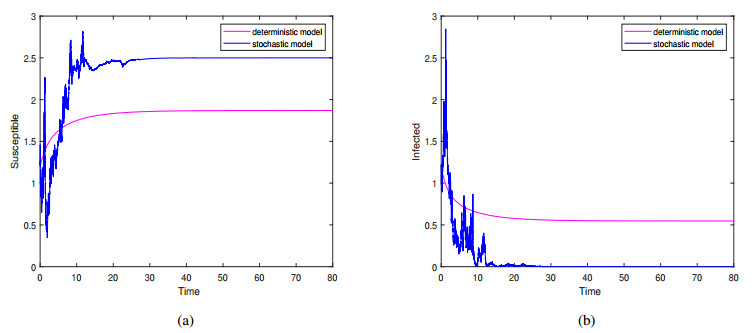









 DownLoad:
DownLoad:







